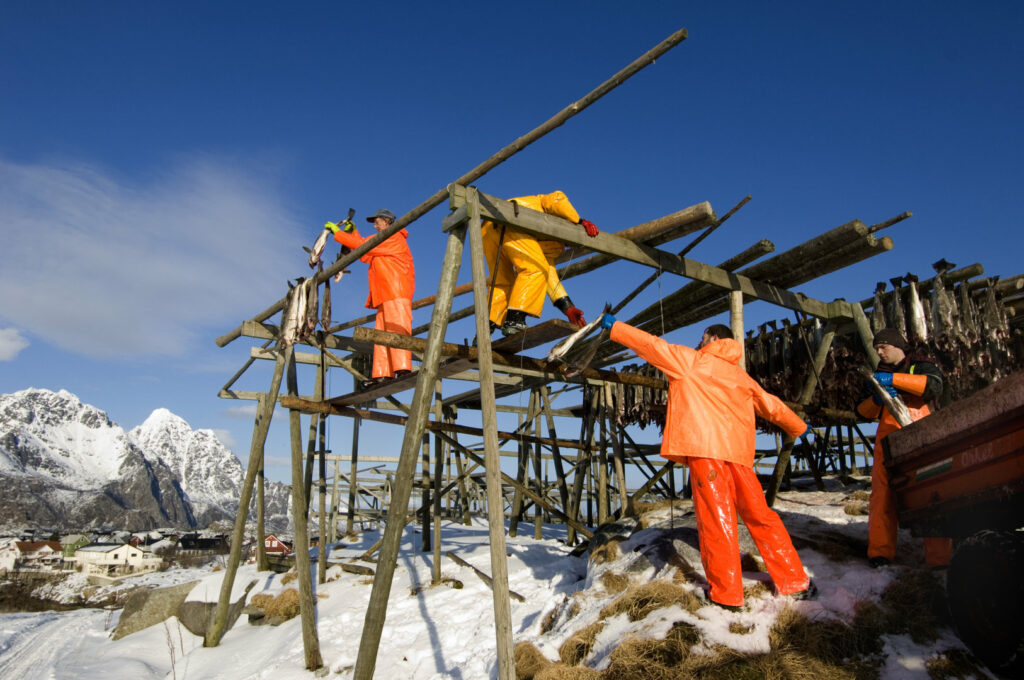
The Legendary Lofoten Fishery
«The fisheries are, and will hopefully always remain, Norway’s most important gold mine». So wrote the Norwegian Parliament in 1816.
Every winter, huge numbers of cod, or skrei, migrate to Lofoten from the Barents Sea in order to spawn. This has provided a living for people in the region for almost five thousand years.
In other words, the Lofoten Fishery is an ancient livelihood. The fisheries eventually grew so big that they also became important for people far outside Northern Norway. In fact, over the past thousand years, the seasonal fishery has been of vital importance for the whole nation
Following the history of cod makes for a fascinating journey through Norway’s history. Sagas, legislation and court records, old accounts and regulations dating back to the 11th century all paint a clear picture. It was the cod that gave us the power and money necessary to establish the church, an administration, monarchy and government and, eventually, our own parliament. The cod made it possible to build the nation stone-by-stone.
Without it, people would not have settled in Northern Norway. Bergen, Ålesund and Kristiansund would never have come into existence. And what about Oslo and the rest of Southern Norway?


Without the Cod, the Vikings would never have existed either
Their most important weapon was not the sword, spear or bow, but the skrei which the people who lived along the coast had learned to dry, in the absence of salt. It was absolutely vital not only as a commodity, but also as ships’ provisions, because in stockfish, they had a nutritious food with an unlimited expiry date which made it possible to survive long voyages to Greenland, Russia and the far south of Europe – even to America, 500 years before Columbus.
The first exporter of stockfish we know of was Torolf Kveldulfson. According to Egil’s saga, he travelled to Lofoten in 870 with his large ship, filled it with stockfish and sailed to England, where he swapped the cargo for essential goods.
The Hanseaten, who had their own fleet of warships, dominated trade across much of Northern Europe. Stockfish became one of the most important products after they became established themselves in Bergen in the late 13th century, as is apparent from the coat of arms. Stockfish takes up half of the coat of arms and even has a crown. Today, the same coat of arms adorns the Hansa Pilsener.
In the 1560s, every year, around 200 boats used to sail from Northern Norway to Bergen carrying stockfish, cod liver oil and roe, which were then sold to countries across Europe. On average, this trade represented an annual value of 105,000 Norwegian spesidaler (the currency of Norway between 1816 and 1875), a sum three times greater than Norway’s state finances combined during this period.
For at least a thousand years, right up until the early 20th century in fact, fishing was carried out from open boats, particularly the larger Nordland boats as well as large rowing boats. These boats were propelled either via sails or oars. By the 1920s, a high proportion of the fishing fleet used engine power, which enabled the boats to have a smaller crew on board. However, the Lofoten Fishery remained a major attraction for fishermen for many years after the Second World War. In 1860, around 24,000 men took part. The popularity of the fishery reached a peak in 1895 when 32,000 fishermen took part. Since 1990, between 2000 and 4000 fishermen have participated every year.
However, the total catch has not declined. A “shark” type fishing boat today is ten times more efficient than its counterpart in times gone by. Modern equipment and larger boats have made it possible for the coastal fleet to fish not only the entire coast, but also out in the open sea. They take large catches out there before the cod reaches Lofoten.

The Lofoten Fishery – important till this day
The Lofoten fishery still attracts fishermen from Finnmark in the north to Mandal in the south as an important seasonal fishery. Especially in March and early April. Then the fish farms along the entire Lofoten Wall bustle with life and huge amounts of fish hang on racks to dry. In June, they take down the fish from the racks, sort it into eighteen different qualities, and export it to several countries around the world. Italy is the biggest importer. In some areas there, they still sing: Viva lo stoccafisso! Viva la Norvegia! (Frank A. Jenssen).



